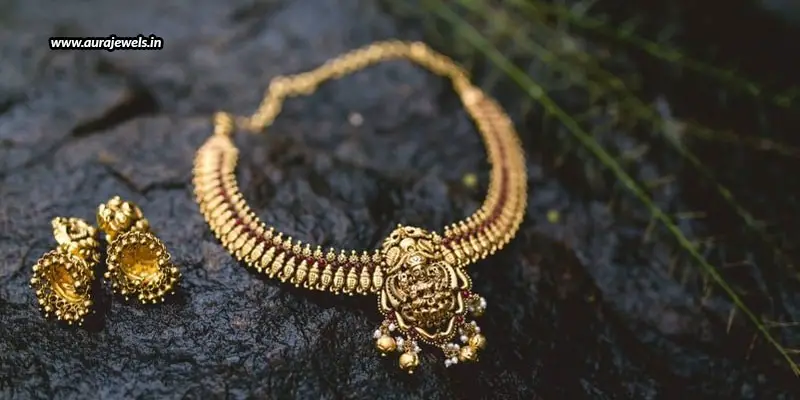Kerala brides are always decked up in crisp clean red or white sarees and clad in lots of gold jewellery. And, with the red and gold, or white and gold combination, every Kerala bride resembles a divine entity! Kerala bridal jewellery takes inspiration from a variety of elements like nature, religion, and community. You could opt for ancient traditional jewellery styles, or modify them to suit the contemporary designs of today. We, in this blog, bring to you suggestions in both styles, to help you choose from what you’d like. We mainly focus on one jewellery element that Kerala brides are always clad with – a variety of short and long necklaces.

The Pathaka
This is the traditional necklace that almost every Kerala bride wears on her special day. It is a gemstone-studded center piece hanging on a thick gold chain, the center piece being an engraved design of the Goddess Lakshmi, symbolizing wealth and prosperity wishing on the bride and her family.
The Lakshmi Mala
This is a staple at Kerala weddings. It typically features small gold coins closely strung together, each coin engraved with a tiny figure of Goddess Lakshmi, to invoke her blessings on the bride as well as the groom.
The Manga Mala
Another necklace, the Manga Mala, is a paisley-shaped necklace traditionally enameled in green lacquer, widely available in different colours and metals. The little paisleys represent tiny mangoes, which are symbolic of love and fertility in the Hindu tradition.
The Mullamottu & Pichimottu Mala
These necklace designs take inspiration from jasmine buds, but the Mullamottu Mala is more rounded, while the Pichimottu Mala is the elongated form of the bud. These necklaces are longer than other necklace types, adding a regal appearance to the bride.
The Avil Mala
This is a shorter necklace than every other necklace worn by a Kerala bride, but no less dramatic. It draws inspiration from puffed flattened rice, which is a staple of Indian cuisine, particularly among the people of Kerala. The necklace is designed with such similar long beads as rice is considered a symbol of abundance and good health.
The Elakkathali
This is a highly polished choker made of intricate strands of gold, sitting above all the other necklaces, shimmering with every moment the bride makes.
The Pulinakha Mala
The shape of the beads in this necklace resembles tiger claws. It could be worn as a short choker style or a longer chain style; whatever it is, it certainly leaves an impression as regal as the tiger itself.
The Nagapada Thali
This necklace has a centerpiece that resembles the hood of the King Cobra. Set in gold and diamonds, this Kerala bridal wear necklace represents both eternity and the three greatest forces of the universe – creation, preservation, and destruction.
The Karimani Mala
This is the largest necklace that a Kerala bride can wear, usually forming an intricate pattern of black and gold beads with a gold mandala in the center. This is nothing else but what every Hindu would call a “Mangalsutra”.
There, you have a whole list of necklace types that you can wear on your D-day. You can also choose to mix your family heirlooms with new customized pieces to bridge the modern world with customary ancient traditions. And for that to be done perfectly, you need an expert like Aura Jewels to help you. Here, you have a team of skilled artisans and designers always ready to accept any challenge coming their way. So, get in touch and have newer designs designed to complement your family heirloom, made with hallmarked gold and genuine diamonds at one of the best diamond jewellery shops in Bangalore. After all, Kerala jewellery is not only about gold, but lots of diamonds too.






